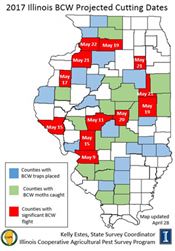Impressive Moth Flights Across Midwest
KELLY ESTES
CHAMPAIGN, ILL.
Impressive moth flights have not only kept the Illinois insect monitoring network cooperators busy, but neighboring states are reporting lots of black cutworm and true armyworm moth activity as well. The current forecast and planting progress has raised questions about the potential for these pests in the coming weeks.
With the assistance of University of Illinois Extension educators, producers and industry volunteers, nearly 60 trap sites have been established across Illinois. Captures of both black cutworm and true armyworm have been common across the state. Several counties have reported significant flights (nine or more moths caught over a 2-day period). In fact, several counties have repeated significant flights.
For more complete information about the biology, life cycle, and management of black cutworms, a fact sheet is available from the Department of Crop Sciences, UIUC. Provided below is a brief overview of some key life cycle and management facts concerning black cutworms.
• Black cutworm moths are strong migratory insects with northward flights commonly observed from Gulf States into the Midwest from March through May.
• Moths are attracted to fields heavily infested with weeds such as chickweed, shepherd’s purse, peppergrass, and yellow rocket.
• Late tillage and planting tends to increase the susceptibility of fields to black cutworm infestations.
• Cutting of corn plants begins when larvae reach the 4th instar – with a single cutworm cutting an average of 3 to 4 plants during its larval development.
• Cutting tends to occur most often during nights or on dark overcast days.
• Fields at greatest risk to cutting and economic damage are in the 1-to-4 leaf stage of plant development.
• An early warning sign of potential economic damage includes small pinhole feeding injury in leaves (caused by the first 3 instars).
• Producers are encouraged to look for early signs of leaf feeding as a potential indicator of cutting, rather than waiting for cutting to take place.
• Don’t assume that all Bt hybrids offer the same level of cutworm protection. Plants in the 1- to 4-leaf stage are most susceptible to cutting.
• Cutting of plants earlier than these projected cutting dates is possible – localized intense flights may have occurred and were not picked up by our volunteers.
• A nominal threshold of 3 percent cutting of plants has traditionally been used as a point at which growers should consider a rescue treatment.
• Not all Bt hybrids offer adequate protection against black cutworm damage. Growers should consult the Handy Bt trait table prepared by Dr. Chris DiFonzo at Michigan State University to determine the level of protection provided by their chosen Bt hybrid.
Switching our focus to true armyworm, this insect has also been very active this spring. Illinois has seen steady flights across the state with numbers slowing down only within the last week. Christian Krupke, Purdue, summarized the potential threat very well in a recent article. Remember, true armyworms prefer to lay eggs in grass covered areas. Wheat as well as corn planted into cover crops will be a prime target. The Handy Bt trait table above is also a great reference for hybrids that may offer some protection, but once again, don’t assume it’s 100 percent full-proof. With significant infestations, some damage may be observed before the Bt-proteins will suppress the feeding.
The take-home message today? Be vigilant with your fields this spring. The mild winter and warm spring certainly got things rolling. This upcoming cool and wet period may slow things down, but both black cutworm and true armyworm moths have been abundant up until this point (and they pick back up again). Please feel free to share updates from the field by email (kcook8@illinois.edu) or twitter (https://twitter.com/ILPestSurvey). ∆
KELLY ESTES: Agricultural Pest Survey Coordinator, University of Illinois

Illinois black cutworm projected potential cutting dates based on degree day accumulations.